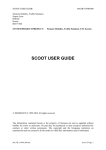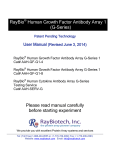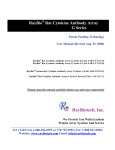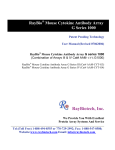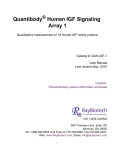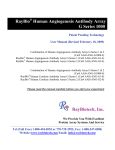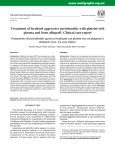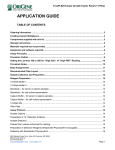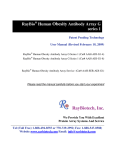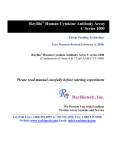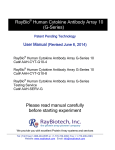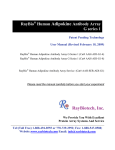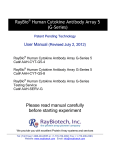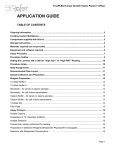Download Manual
Transcript
RayBio® G-Series Human Obesity Antibody Array 1 Patent Pending Technology User Manual (Revised July 1, 2014) 4 Sample Kit (Cat# AAH-ADI-G1-4) 8 Sample Kit (Cat# AAH-ADI-G1-8) Human Obesity Array G1 Service (Cat# AAH-ADI-G1-SERV) Please read the manual carefully before you start your experiment RayBiotech, Inc. We Provide You With Excellent Protein Array Systems and Service Tel: (Toll Free) 1-888-494-8555 or 770-729-2992; Fax: 1-888-547-0580; Website:www.raybiotech.com Email: [email protected] RayBiotech, Inc. RayBio® Human Obesity Antibody Array G1 Protocol TABLE OF CONTENTS I. Introduction····················································································2 How It Works……………………………………………………………………………….5 II. Product Information………………………………………………………….……6 A. Materials Provided…………………………………………………………..6 C. Additional Materials Required…………………………………6 E. RayBio® G-Series Glass Chip Layout ……………………6 III. Overview and General Considerations…………………..…7 A. Preparation and Storage of Samples·………………...7 B. Handling Glass Chips……………………………………………………….8 C. Incubations and Washes………………………………………………8 D. Data Extraction Tips………………………………………………………..8 IV. Protocol……………………………………………………………………………………………9 A. Preparation and Storage of Reagents……………….9 B. Blocking and Incubations……………………………………………10 C. Fluorescence Detection………………………………………………13 V. Interpretation of Results…………………………………………………….14 A. Explanation of Control Spots……………………………….14 B. Typical Results using G-Series Arrays…………….14 C. Background Subtraction………………………………………….15 D. Normalization of Array Data··································15 E. Threshold of Significance………………………………………..16 VI. Antibody Array Map……………………………………………………………….17 VII. Troubleshooting Guide………………………………………………………..18 VIII. Selected References………………………………………………………………19 Cytokine Antibody Arrays are RayBiotech patent-pending technology. RayBio® is the trademark of RayBiotech, Inc. RayBio® Human Obesity Array G1 1 I. Introduction All cell functions, including cell proliferation, cell death and differentiation, as well as maintenance of health status and development of disease, are controlled by many genes and signaling pathways. New techniques such as cDNA microarrays have enabled us to analyze the global gene expression 1-3. However, almost all cell functions are executed by proteins, which cannot be studied by DNA and RNA alone. Experimental analysis clearly shows a disparity between the relative expression levels of mRNA and their corresponding proteins 4. Therefore, it is critical to analyze the protein profile. Currently, two-dimensional polyacrylamide SDS page coupled with mass spectrometry is the mainstream approach to analyzing multiple protein expression levels 5,6. However, the requirement of sophisticated devices and the lack of quantitative measurements greatly limit its broad application. Thus, no simple, cost effective, and rapid method of analysis of multiple protein expression levels has been available to researchers until now. Our RayBio® Human Cytokine Antibody Array is the first commercially available protein array system 7-11. By using the RayBiotech system, scientists can rapidly and accurately identify the expression profiles of multiple cytokines in several hours inexpensively. The RayBiotech kit (G series) is a glass slide format. The kit provides a highly sensitive approach to simultaneously detect multiple cytokine expression levels from cell culture supernatant, patient’s serum, tissue lysate and other sources. The arrays are manufactured using non-contact arrayer. The experimental procedure is simple and can be performed in any laboratory. The signals from G series arrays are detected using a laser scanner. Besides the products listed in this manual, RayBiotech also provides RayBio® Human Cytokine Antibody Array G series 1000 for detection of 120 human cytokines in single experiment, RayBio® Human Cytokine Antibody Array G series 2000 for detection of 174 human cytokines in single experiment and RayBio® Human Cytokine Antibody Array G series 4000 for detection of 274 human cytokines in single experiment. Pathway-specific array systems allow investigators to focus on the specific problem and are becoming an increasingly powerful tool in cDNA microarray system. RayBiotech’s first protein array system, known as RayBio® Human Obesity Antibody Array, is particularly useful compared with the human adipokine cDNA microarray system. Besides the ability to detect protein expression, RayBiotech’s system is a more accurate reflection of active adipokine levels because it only detects secreted adipokines, and no amplification step is needed. Furthermore, it is much simpler, faster, environmentally friendlier, and more sensitive. Simultaneous detection of multiple adipokines undoubtedly provides a powerful tool to study obesity. The area of obesity research is getting hotter ever over the past years. One of the key driving factor is that adipose tissue is found no longer to be an inert energy storage organ, but is emerging as an active participant in regulating physiological and pathologic processes. RayBio® Human Obesity Array G1 2 Many soluble factors have been identified from the adipose tissue and are so called as adipocytokines or adipokines. But adipokines are also expressed in a number of other tissues and organs. Because all of these factors can act in an autocrine, paracrine and endocrine manner in the organisms, adipokines are thought to serve as mediators linking obesity, inflammation, immunity and other obesity related diseases 12-15. Without doubt, simultaneous detection of multiple adipokines provides a powerful tool to study adipokines. References: 1. LPS induces the interaction of a transcription factor, LPS-induced TNF-a factor, and STAT6(B) with effects on multiple cytokines. Xiaoren Tang, Deborah Levy Marciano, Susan E. Leeman and Salomon Amar. PNAS. April 5, 2005 vol. 102 no. 14 5132-5137 2. HIV-1-mediated apoptosis of neuronal cells: Proximal molecular mechanisms of HIV-1induced encephalopathy. Yan Xu, Joseph Kulkoshy, Roger j. Pomerantz. PNAS. 2004 May 4, 2004 Vol. 101 No. 18. 3. Synergistic increases in intracellular Ca(2+), and the release of MCP-1, RANTES, and IL-6 by astrocytes treated with opiates and HIV-1 Tat. GLIA. 2005 Apr 15;50(2):91-106. 4. Bone Marrow Stroma Influences Transforming Growth Factor-β Production in Breast Cancer Cells to Regulate c-myc Activation of the Preprotachykinin-I Gene in Breast Cancer Cells. Hyun S. Oh, Anabella Moharita… Pranela Rameshwar. CANCER RESEARCH. 64, 6327-6336, September 1, 2004 5. Recombinant Herpes Simplex Virus Type 1 (HSV-1) Codelivering Interleukin-12p35 as a Molecular Adjuvant Enhances the Protective Immune Response against Ocular HSV-1 Challenge JOURNAL OF VIROLOGY. Mar. 2005 Vol. 79, No. 6. 6. Dysregulated Inflammatory Response to Candida albicans in a C5-Deficient Mouse Strain. Alaka Mullick, Miria Elias, Serge Picard, Philippe Gros. Infection and Immunity, Oct. 2004, p. 5868-5876, DOI: 10.1128/IAI.72.10.5868-5876.2004 7. Leukotriene B4 Strongly Increases Monocyte Chemoattractant Protein-1 in Human Monocytes Li Huang, Annie Zhao, Frederick Wong, Julia M. Ayala, Jisong Cui Arteriosclerosis, Thrombosis, and Vascular Biology. 2004;24:1783-1788 8. Human CD1d-unrestricted NKT cells release chemokines upon Fas engagement. Martin Giroux and François Denis. Yan Xu, Joseph Kulkoshy, Roger j. Pomerantz. Blood. prepublished online September 2, 2004; DOI 10.1182/blood-2004-04-1537 RayBio® Human Obesity Array G1 3 9. Monitoring the response of orthotopic bladder tumors to granulocyte macrophage colony-stimulating factor therapy using the prostate-specific antigen gene as a reporter. Wu Q, Esuvaranathan K, Mahendran R. Clinical Cancer Research. 2004 Oct 15; 10(20):6977-84. 10. Neuroglial activation and neuroinflammation in the brain of patients with autism (p NA). Diana L. Vargas, Caterina Nascimbene, Chitra Krishnan, Andrew W. Zimmerman, Carlos A. Pardo. Annals of Neurology. 2005 Jan 1; DOI: 10.1002/ana.20315 11. Cytokine profiling of macrophages exposed to Porphyromonas gingivalis, its LPS or its FimA. Qingde Zhou, Tesfahun Desta, Dana T. Graves and Salomon Amar. Infection and Immunity (IAI). 2005 Feb;73(2):935-43. 12. Veto-like activity of mesenchymal stem cells: functional discrimination between cellular responses to alloantigens and recall antigens. Rameshwar P. Journal of Immunology. 2003 Oct 1;171(7):3426-34. 13. Cytokine responses elicited in endothelial cells after treatment with a specific toxin. Jaya Pandey. BioCompare Product Review. May 13, 2004 14. Proteomic Characterization of the Interstitial Fluid Perfusing the Breast Tumor Microenvironment. A Novel Resource for Biomarker and Therapeutic Target Discovery. Julio E. Celis, Pavel Gromov, Teresa Cabezón, José M. A. Moreira, Noona Ambartsumian, Kerstin Sandelin, Fritz Rank, and Irina Gromova. Molecular Cellular Proteomics. April 2004; 11(3):328-39. 15. Increased Expression and Secretion of Interleukin-6 in Patients with Barrett’s Esophagus.. Katerina Dvorakova, Harinder Garewal Clinical Cancer Research. 2004 Mar 15;10(6):2020-8. 16. Antibody array-generated profiles of cytokine release from THP-1 leukemic monocytes exposed to different amphotericin B formulations. Turtinen LW, Prall DN, Bremer LA, Nauss RE, Hartsel SC. Antimicrobial Agents Chemotherapy. 2004 Feb;48(2):396-403. 17. The promise of cytokine antibody arrays in drug discovery process. R.-P. Huang, W. Yang, D. Yang, L. Flowers, I. R. Horowitz, X. Cao and R. Huang. Expert opinion on drug discovery. (2005) 9:601-615. RayBio® Human Obesity Array G1 4 Here’s how it works 1 - 2 hours 1 - 2 hours 1 hour RayBio® Human Obesity Array G1 5 II. Materials Provided Store kit at ≤ -20 °C immediately upon arrival. Kit must used within the 6 month expiration date. ITEM COMPONENT 5 6 7 Human Obesity Array G1 Glass Slide Blocking Buffer Human Obesity Array G1 Biotinylated Antibody Cocktail 1,500X Fluorescent Dyeconjugated Streptavidin (Cy3 equivalent) 20X Wash Buffer I Concentrate 20X Wash Buffer II Concentrate 2X Cell Lysis Buffer Concentrate 8 G-Series Array Accessories 1 2 3 4 AAH-ADI-1-4 AAH-ADI-1-8 4 subarrays 8 subarrays 10 ml 20 ml 1 tube 2 tubes STORAGE TEMPERATURE AFTER THAWING** ≤ -20 °C 2-8 °C (for up to 3 days after dilution) 1 tube 30 ml 30 ml 10 ml Slide incubation chamber, gasket, protective cover, snapon sides and adhesive film 2-8 °C Room Temperature Additional Materials Required • • • • • Orbital shaker Laser scanner for fluorescence detection Aluminum foil Distilled water Plastic box Layout of G-Series Slides Antibody Array Antibody Array Blank Blank Barcode Barcode 8 arrays in one glass chip 4 arrays in one glass chip RayBio® Human Obesity Array G1 6 III. Overview and General Considerations A. Preparation and Storage of Samples 1. General Considerations: • Freeze samples as soon as possible after collection. • Avoid multiple freeze-thaw cycles. If possible, sub-aliquot your samples prior to initial storage. • Spin samples hard (5-10 minutes at 10K to 15K RPM) immediately prior to incubation of samples with array. • Optimal sample concentrations may need to be determined empirically based on the signal intensities of spots and background signals obtained. • Most samples will not need to be concentrated. If concentration is required, we recommend using a spin-column concentrator with a chilled centrifuge. 2. Recommended Sample Volumes and Dilution Factors NOTE: All sample dilutions should be made using 1X Blocking Buffer. Final sample volume = 50-100 μl per sub-array • • • • o o o o Cell Cultured Media: Neat (no dilution needed) Serum & Plasma: 5-fold to 10-fold dilution Most other Body Fluids: Neat or 2-fold to 5-fold dilution Cell and Tissue Lysates: Minimum 5-fold to 10 fold to equal concentrations of total protein in each lysate sample. You must determine the total protein concentration of each lysate/homogenate. We recommend using the BCA method (available from Pierce); it is insensitive to detergents commonly found in lysis buffers. Minimum Recommended Dilution of Lysates (prior to sample incubation): 5-fold to 10 fold with 1X Blocking Buffer. Dilute all lysate samples to the same final concentration of total lysate protein in 1X Blocking Buffer to 100 μl final volume. To start, we recommend using 10-100 μg of total protein in 100 μl of 1X Blocking Buffer (final volume) per sub-array. Optimal amounts of total lysate protein may range from 5-500 μg per subarray. Based upon background and spots intensities, you may increase or decrease the amount of protein used in subsequent experiments. RayBio® Human Obesity Array G1 7 • Other Liquid Sample Types: Most often Neat or 2-fold to 5-fold. However, optimal dilutions should be determined empirically. For tips on sample preparation, please visit our Website: http://www.raybiotech.com/Tech-Support/SampleTips.pdf B. Handling Glass Chips • Do not remove glass chip from assembly until Step 16. • Hold the slides by edges only; do not touch the surface. • Handle all buffers and slides with powder-free gloves. • Dry glass chip completely before proceeding to Step 3. • Handle and dry glass chip in clean environment. • Avoid breaking glass chip when removing the chamber assembly. C. Incubations and Washes • Cover incubation chamber with adhesive film (included in kit) to prevent evaporation, particularly during incubation or wash steps >2 h or with liquid volumes <100 μl per well. • Perform all incubation and wash steps under gentle rotation or rocking motion (~0.5 to 1 cycle/s). • Wash steps in Wash Buffer II and all incubation steps may be performed overnight at 4°C. o Overnight sample incubations are the most effective at increasing sample spot intensities. • Avoid cross-contamination of samples to neighboring wells • To remove Wash Buffers and other reagents from chamber wells, you may invert the Glass Chip Assembly to decant, and aspirate the remaining liquid. • In Wash Steps 6, 12 and 15, you may gently flush wells several times using a wash bottle filled with Wash Buffer I. D. Scanning and Data Extraction Tips: For tips on scanning and data extraction, please visit our Website: http://www.raybiotech.com/Tech-Support/ScanningTips.pdf For a list of recommended scanners, please http://www.raybiotech.com/TechSupport/Laser_Scanners_for_Glass_Slide_Arrays.pdf. RayBio® Human Obesity Array G1 8 visit our Website: IV. Protocol A. Preparation and Storage of Reagents NOTE: During this protocol, prepare reagents immediately prior to use and keep working dilutions of all reagents on ice at all times. 1. Blocking Buffer supplied as 1X. No dilution is required. 2. Wash Buffers I and II are supplied at 20X concentration. a). For each glass chip (4 or 8 sub-arrays/chip), dilute 6 ml of 20X concentrate with deionized H20 to a final volume of 120 ml each of Wash Buffer I & Wash Buffer II. b). Wash buffer reagents at working dilution (1X) can be stored at 4°C for up to 1 month. Stock solutions at 20X can be stored 4°C for up to 3 months. 3. Biotin-conjugated Anti-Cytokines are supplied at high concentration in a small liquid bead (typically ~2-5 μl). a). Spin down the tube prior to reconstitution, as the concentrated liquid bead may have moved to the top of the tube during handling. b). Prepare stock reagent by adding 300 μl 1X Blocking Buffer to BiotinConjugated Anti-Cytokines. Mix well. c). 1X Biotin-Conjugated Anti-Cytokines may be stored for 2-3 days at 4°C. 4. Streptavidin-Fluor is supplied at 1500x concentration. a). Mix the tube containing 1500X Streptavidin-Fluor well before use, as precipitants may form during storage. b). Add 100 μl of 1X Blocking Buffer to tube containing 1500X StreptavidinFluor. Mix well. c). Quantitatively transfer all of Streptavidin-Fluor reagent from the original tube to a larger one, and dilute with 1X Blocking Buffer to a final volume of 1500 μl (ie, 1.5 ml). d). Wrap tube containing Streptavidin-Fluor with aluminum foil. e). This working dilution can be stored for 3-5 days at 4°C. RayBio® Human Obesity Array G1 9 B. Blocking and Incubations NOTE: Please carefully read Section III of this manual before proceeding NOTE: Prepare all reagents immediately prior to use as described above (Section IV.A) and before proceeding. 1) Remove the package containing the glass chip assembly from the freezer. Place unopened package on the benchtop and allow the glass chip assembly to equilibrate to room temperature (RT), approx. 15 min. Open package, remove the glass chip assembly and place in laminar flow hood to dry for 1-2 hours. NOTE: Be sure glass chip is completely dry before proceeding. 2) If necessary, assemble the glass chip into incubation chamber and frame as shown below. (Note: if you slide is already assembled, you can proceed directly to Step 3). RayBio® Human Obesity Array G1 10 3) Add 100 μl 1 X Blocking Buffer into each well and incubate at RT for 30 min to block slides. NOTE: Only add reagents or samples to wells printed with antibodies (see diagram on page 6) 4) Decant Blocking Buffer; then aspirate remaining liquid from each well. NOTE: To aspirate liquid samples or reagents from wells, gently place the pipette tip only in the corners of the well. Do not scrape the pipette tip across the surface of the chip. 5) Add 50 to 100 μl of each sample to each sub-array. Cover the incubation chamber with Adhesive film (included in kit). Incubate arrays with sample at RT for 2 hours. Dilute sample using 1X Blocking Buffer if necessary. 6) Remove adhesive film, and carefully aspirate samples from sub-arrays, touching only the corners with your pipette tip. NOTE: Try to prevent solution from flowing into neighboring wells. RayBio® Human Obesity Array G1 11 7) Wash 3 x 2 min with 150 μl 1X Wash Buffer I at RT. Be sure to completely remove sample and Wash Buffer each time and use fresh buffer for each wash. Decant final wash solution before proceeding to next step. 8) Obtain a clean container (eg, pipette tip box or slide staining jar) and place glass chip assembly into the container. Add enough 1X Wash Buffer I to submerge the entire glass chip with frame intact (approx. 30-50 ml) and remove all bubbles in wells. Wash 10 min at RT with gentle rocking or shaking. 9) Remove assembled glass chip from container and invert it to decant liquid. Decant buffer from container and replenish with 1X Wash Buffer I. Submerge the entire glass chip assembly and wash 10 min at RT with gentle rocking or shaking. 10) Remove assembled glass chip from container and invert it to decant liquid. Decant buffer from container and repeat Steps 8 & 9 with Wash Buffer II. 11) Remove assembled glass chip from container and invert it to decant liquid, then carefully aspirate wash buffer from wells, touching only the corners with your pipette tip. 12) Add 70 μl of 1X Biotin-conjugated Anti-Cytokines to each sub-array. Cover incubation chamber with Adhesive film (included in kit). Incubate at RT for 2 hours with gentle rocking or shaking. 13) Carefully aspirate all of the Biotin-conjugated Anti-Cytokine reagent. Wash as described in Step 7 above, first with Wash Buffer I then with Wash Buffer II, making sure to completely remove buffer between washes and after final wash. 14) Add 70 μl of 1X Streptavidin-Fluor to each sub-array. Cover the incubation chamber with Adhesive film (included in kit), then cover entire assembly with aluminum foil to avoid exposure to light or incubate in dark room. Incubate at RT for 2 hours with gentle rocking or shaking. 15) Remove aluminum foil and adhesive film. Carefully aspirate the StreptavidinFluor reagent. Wash as described in Step 7 above, first with Wash Buffer I then with Wash Buffer II, making sure to completely remove buffer between washes and after final wash. RayBio® Human Obesity Array G1 12 16) Remove the glass chip from the frame assembly. Place the whole chip in 30 ml centrifuge tube provided, or slide staining jar. Add enough Wash Buffer I to cover the whole slide (about 20 ml) and gently rock or shake at RT for 10 min. 17) Decant buffer and repeat wash as described in Step 16 (1 x 10 min with Wash Buffer I). 18) Decant buffer and repeat wash as described in Step 16, but this time using Wash Buffer II for only 2-3 minutes. 19) Decant buffer, remove the glass chip from the tube, then gently rinse the slide with de-ionized H2O using a plastic wash bottle. 20) Remove water droplets by applying suction gently with a pipette tip. NOTE: Be careful not to touch the array portions of the slide with your pipette tip, only touch the sides of the slide. C. Obtaining Fluorescent Signal Intensities: 21) Allow glass chip to dry in a laminar flow hood for 20 minutes or until slide is completely dry. Place chip under an aluminum foil tent to protect it from light. Make sure the slides are absolutely dry before scanning or storage. 22) You may proceed immediately to scanning (Step 23), or you may scan at a later time. You may store the slides at RT indefinitely, provided they are protected from strong light. NOTE: Unlike most Cy3 fluors, the HiLyte Plus™ Fluor 555 used in this kit is very stable at RT and resistant to photobleaching on completed glass chips. However, please protect glass chips from strong light and temperatures above RT. 23) Scan the glass chip with a laser scanner (such as Innopsys’ InnoScan®) using cy3 or “green” channel (excitation frequency = 532 nm). For tips on scanning, visit our Website: http://www.raybiotech.com/Tech-Support/ScanningTips.pdf NOTE: If you do not have a laser scanner, for a nominal fee you can send your slide to us for scanning and data extraction using Innopsys’ InnoScan, and we will return the results to you. Using using alternate protocols, RayBio® G-Series RayBio® Human Obesity Array G1 13 arrays are also compatible with Li-Cor’s Odyssey and other microarray scanners. V. Interpretation of Results: A. Explanation of Controls Spots Positive Controls (POS1, POS2, POS3) are equal amounts of biotinylated IgGs printed directly onto the array. All other variables being equal, the Positive Control intensities will be the same for each sub-array This allows for normalization based upon the relative fluorescence signal responses to a known control, much as “housekeeping” genes or proteins are used to normalize results in PCR or Western blots, respectively. Negative Control (NEG) spots are a protein-containing buffer (used to dilute antibodies printed on the array). Their signal intensities represent non-specific binding of Biotin-conjugated anti-Cytokines and/or Streptavidin-Fluor. Negative control signal intensities are usually very close to background signals in each sub-array. B. Typical results from RayBio® G-Series Antibody Arrays The following figure shows typical results obtained using RayBio® Antibody Array G-Series Arrays. The images were captured using a GenePix 4000B scanner. RayBio® Human Obesity Array G1 14 In this example, sera from several patients were incubated with Human Cytokine Arrays 6, 7 & 8, (sold together as Human Cytokine Array G-Series 2000, AAH-CYTG2000-4 or AAH-CTY-G2000-8) and processed using this standard protocol. The 6 strong signals of the Positive Control spots in the upper-left corner are useful for proper orientation of the array image. If scanned using optimal scan settings, 3 distinct Positive Control signal intensities will be seen: POS1>POS2>POS3. If all of these signals are of similar intensity, try increasing or decreasing laser power and/or signal gain settings. Once you have obtained fluorescence intensity data, you should subtract the background and normalize to the Positive Control signals before proceeding to analysis. C. Background Subtraction: Most laser fluorescence scanner software have an option to automatically measure the local background around each spot. As with spot signal intensities, we recommend using MEDIAN background signals. If your resulting fluorescence signal intensity reports do not include these values (eg, a column labeled as “MED532-B532”), you may need to subtract the background manually or change the default settings on your scanner’s data report menu. D. Normalization of Array Data: To normalize signal intensity data, one sub-array is defined as "reference" to which the other arrays are normalized. This choice can be arbitrary. For example, in our Analysis Tool Software, the array represented by data entered in the left-most column each worksheet is the default “reference array.” You can calculate the normalized values as follows: X(Ny) = X(y) * P1/P(y) Where: P1 = mean signal intensity of POS spots on reference array P(y) = mean signal intensity of POS spots on Array "y" X(y) = mean signal intensity for spot "X" on Array "y" RayBio® Human Obesity Array G1 15 X(Ny)= normalized signal intensity for spot "X" on Array "y" The RayBio® Analysis Tool software is available for use with data obtained using RayBio® G-Series Arrays. You can copy and paste your signal intensity data (with and without background) into the Analysis Tool, and it will automatically normalize signal intensities to the Positive Controls. To order the Analysis Tool, please contact [email protected] for more information. us at +1-770-729-2992 or E. Threshold of significant difference in expression: After subtracting background signals and normalization to Positive controls, comparison of signal intensities for antigen-specific antibody spots between and among array images can be used to determine relative differences in expression levels of each analyte (ie, protein detected) between samples or groups. Any ≥1.5-fold increase or ≤0.65-fold decrease in signal intensity for a single analyte between samples or groups may be considered a measurable and significant difference in expression, provided that both sets of signals are well above background (Mean background + 2 standard deviations, accuracy ≈ 95%). NOTE: In the absence of an external standard curve for each analyte, there is no means of assessing absolute or relative concentrations of different analytes in the same sample using immunoassays. If you wish to obtain quantitative data (ie, concentrations of the various analytes in your samples), try using our Quantibody® Multiplex ELISA arrays instead. Data Extraction Tips: • Ignore any comet tails • Define the area for signal capture for all spots as 110-120 micron diameter,using the same area for every spot. • Use median signal value, not the total or the mean • Use local background correction (also median value). • Exclude obvious outlier data in its calculations. • Scan all slides at same PMT RayBio® Human Obesity Array G1 16 VI. RayBio Human Obesity Array G1 Map Detects 62 cytokines in one experiment A B C D E F 1 POS1 POS2 POS3 NEG 4-1BB ACE-2 2 POS1 POS2 POS3 NEG 4-1BB ACE-2 3 Fas GH HCC-4 4 Fas GH HCC-4 IFNgamma IFNgamma IGFBP1 IGFBP1 5 IL-6 IL-8 IL-10 IL-11 IL-12 6 IL-6 IL-8 IL-10 IL-11 IL-12 7 MCSF MIF OSM PAI-I PARC MCSF MIF MSP alpha MSP alpha OPG 8 OPG OSM PAI-I PARC 9 SDF-1 10 SDF-1 MIP-1 beta MIP-1 beta sTNF RII sTNF RII TGFBeta TGFBeta TIMP1 TIMP1 TIMP -2 TIMP -2 TNFalpha TNFalpha FGF6 FGF6 IL-6 sR IL-6 sR sTNF RI sTNF RI TECK TECK G ACRP -30 ACRP -30 IGFB P-2 IGFB P-2 Insuli n Insuli n H I J ANGPT 1 ANGPT 1 Adipsin AgRP Adipsin AgRP IGFBP-3 IGF-I IGF-I sR IGFBP-3 IGF-I IGF-I sR IP-10 Leptin IP-10 Leptin K ANGPT 2 ANGPT 2 IL-1 alpha IL-1 alpha PDGFAA PDGFAA Leptin R Leptin R PDGFAB PDGFAB PDGFBB PDGFBB VEGF XEDAR VEGF XEDAR LIF L ANGPTL 4 ANGPTL 4 M CRP CRP IL-1 beta IL-1 sRI IL-1 beta IL-1 sRI Lympho tactin Lympho tactin N ENA78 ENA78 IL-1 R4/ST2 IL-1 R4/ST2 MCP-1 MCP-3 MCP-1 MCP-3 RANTES Resistin SAA RANTES Resistin SAA NEG NEG NEG NEG NEG NEG NEG NEG LIF Note: IL-12 only recognizes IL-12 p70 Abbreviations: GH, Growth Hormone; IP-10, Interferon-inducible protein-10; LAP, latency associated peptide (TGF-b1); LIF, leukocyte inhibitory factor. MMP, Matrix Metalloproteinase; SAA, Serum Amyloid A; Pos, positive control; Neg, negative control. All other are used standard abbreviations. RayBio® Human Obesity Array G1 17 VII. Troubleshooting guide Problem Cause Recommendation No signal for any spots, including Positive Controls Global detection failure Adjust scanner settings or re-assemble chip into holder, wash slide 2 x 5 min with 150 μl Wash Buffer II and repeat Steps 12-21. Similar signal intensities for POS1/2/3 Improper laser power and/or PMT setting Repeat scan using higher and/or lower laser power or PMT settings Incomplete washes Carefully follow wash protocols, and/or increase wash times Sample concentration is too high Repeat using lower sample concentration Fluor and/or Anti-Cytokines are too concentrated Review protocol for dilution of reagents Bubbles present on chip during incubations Be sure to completely remove all bubbles from chip surface Evaporation during incubation steps Cover chamber assembly during washes and incubations Pooling/precipitation of sample or reagent; Incomplete washes. Cover chamber assembly and use a rocker or shaker during washes and incubations; carefully follow wash protocols. Sample is too concentrated Repeat experiment using more dilute sample Dust or other particulates Dry slides in laminar flow hood and/or use clean containers and powder-free gloves. Sample is too dilute Repeat experiment using higher sample concentration Improper dilution of AntiCytokines or Streptavidin-Fluor Re-assemble chip into holder, wash 2 x 5 min with 150 μl Wash Buffer II and repeat Steps 12-21. Spin down reagents before diluting and mix well. High background signals Uneven background and/or missing spots Randomly scattered high-intensity spots Rescan at higher laser power or signal gain setting Weak or no signals antigen-specific pots + Low Background Repeat using higher sample concentration and/or incubate with sample O/N at 4°C Other Tips Increase concentration of and/or length of incubation with Biotin-conjugated Anti-Cytokine (+ add’l large volume wash following Biotin-Ab incubation Review proper storage conditions for kit components RayBio® Human Obesity Array G1 18 III. Selected References Citing RayBio® Human G-Series Arrays 1. Mamlouk O, Balagurumoorthy P, Wang K, Adelstein SJ, Kassis AI. Bystander effect in tumor cells produced by iodine-125 labeled human lymphocytes. Intl J Radiation Biol. 2012. DOI:10.3109/09553002.2012.702297. 2. Kocaoemer A, Kern S, Kluter H, Bieback K. Human AB serum and thrombin-activated platelet-rich plasma are suitable alternatives to fetal calf serum for the expansion of mesenchymal stem cells from adipose tissue. Stem Cells. 2007; 25: 1270-1278 3. Ye Z, Lich JD, Moore CB, Duncan JA, Williams KL, Ting JP-Y. ATP Binding by Monarch-1/NLRP12 is critical for its inhibitory function. Mol Cell Biol. 2008;28:1841-1850.. 4. Sommer G, Kralisch S, Stangl V, Vietzke A, et al. Secretory products from human adipocytes stimulate proinflammatory cytokine secretion from human endothelial cells. J Cell Biochem. 2009;106(4): 729–737. 5. Bouazza B, Kratassiouk G, Gjata B, Perie S, et al. Analysis of growth factor expression in affected and unaffected muscles of oculopharyngeal muscular dystrophy (OPMD) patients: A pilot study. Neuromusc Disorders. 2009;19(3): 199-206. 6. Dumortier J, Streblow DN, Moses AV, Jacobs JM, et al. Human Cytomegalovirus Secretome Contains Factors That Induce Angiogenesis and Wound Healing. J Virol. 2008; 82(13): 6524-655. 7. Keren Z, Braun-Moscovici Y, Markovits D, Rozin A, Nahir M, et al. Depletion of B lymphocytes in rheumatoid arthritis patients modifies IL8-anti-IL-8 autoantibody network. Clin Immunol. 2009. doi:10.1016/j.clim.2009.07.001 8. Rovin BH, Song H, Hebert LA, Nadasdy T, et al. Plasma, urine, and renal expression of adiponectin in human systemic lupus erythematosus. Kidney Int. 2005;68: 1825-1833. 9. Duncan JA, Gao X, Huang MT-H, O'Connor BP, Thomas CE, et al. Neisseria gonorrhoeae Activates the Proteinase Cathepsin B to Mediate the Signaling RayBio® Human Obesity Array G1 19 Activities of the NLRP3 and ASC-Containing Inflammasome. J Immunol. 2009;182: 6460-6469. 10. Pukstadad BS, Ryana L, Floa TH, Stenvika J, et al. Non-healing is associated with persistent stimulation of the innate immune response in chronic venous leg ulcers. J Dermatol Sci. 2009;59(2): 115-122. 11. Park JE, Tan HS, Datta A, Lai RC, et al. Hypoxic Tumor Cell Modulates Its Microenvironment to Enhance Angiogenic and Metastatic Potential by Secretion of Proteins and Exosomes. Mol Cell Proteom. 2010;9: 1085-1099. 12. Streblow DN, Dumortier J, Moses AV, Orloff SL, Nelson JA. Mechanisms of Cytomegalovirus-Accelerated Vascular Disease: Induction of Paracrine Factors That Promote Angiogenesis and Wound Healing. Shenk TE, Stinski MF, eds. Current Topics in Microbiology and Immunology: Human Cytomegalovirus. Berlin, Heidelberg, Germany: Springer. 2008;325: 397415. 13. Nolting T, Lindecke A, Koutsilie E, Maschke M, et al. Measurement of soluble inflammatory mediators in cerebrospinal fluid of human immunodeficiency virus–positive patients at distinct stages of infection by solid-phase protein array. J Neruovirol. 2009;15(5-6): 390-400. 14. Pannebaker C, Chandler HL, Nichols JJ. Tear proteomics in keratoconus. Mol Vision. 2010;16: 1949-1957. RayBio® Human Obesity Array G1 20 Customized RayBio® Cytokine Antibody Arrays. Select your cytokines of interest from the following list, and we will produce the customized array for you. For more information, please visit our website, www.raybiotech.com. 4-1BB ACE-2 Acrp30 Activin A Adiposin Adipsin AgRP ALCAM α-Fetoprotein Amphiregulin Angiogenin Angiopoietin-1 Angiopoietin-2 Angiostatin ANGPTL4 Axl B7-1 BCAM BCMA BDNF β2M β IG-H3 bFGF BLC BMP-4 BMP-5 BMP-6 BMP-7 β-NGF BTC CA125 CA15-3 CA19-9 CA IX Cardiotrophin-1 Cathepsin S CCL14a CCL21 CCL-28 CD14 CD23 CD30 CD40 CD40 Ligand CD80 CEA CEACAM-1 CK b 8-1 CNTF Cripto CRP CTACK CXCL16 DAN Decorin Dkk-1 Dkk-3 Dkk-4 DPPIV DR6 Dtk E-Cadherin EDA-A2 EGF EGFR EG-VEGF ENA-78 Endoglin Eotaxin Eotaxin-2 Eotaxin-3 Ep CAM ErbB2 ErbB3 EPO R E-Selectin Fas Fas Ligand Fcr RIIB/C Ferritin FGF-4 FGF-6 FGF-6 FGF-7 FGF-9 Fit-3 Ligand FLRG Follistatin Fractalkine FSH Furin Galectin-7 GCP-2 G-CSF GDF-15 GDNF RayBio® Human Obesity Array G1 GITR GITR Ligand GM-CSF GRO GROα GH HB-EGF HCC-4 hCG (intact) HGF HVEM I-309 ICAM-1 ICAM-2 ICAM-3 IFNγ IGF-1 SR IGFBG-1 IGFBP-2 IGFBP-3 IGFBP-4 IGFBP-6 IGF-I IGF-I SR IGF-II IL-1α IL-1β IL-1 R II IL-1 R4/ST2 IL-1 RI IL-1 sRI IL-10 IL-10 Rα IL-10 Rβ IL-11 IL-12 IL-12 p40 IL-12 p70 IL-13 IL-13 Rα-2 IL-13 RI IL-15 IL-16 IL-17 IL-17B IL-17C IL-17F IL-17R IL-18 BPα IL-18 Rβ IL-1ra IL-2 IL-2 Rβ IL-2 Rγ IL-2 Ra IL-21R IL-22 IL-28A IL29 IL-3 IL-31 IL-4 IL-5 IL-5 Rα IL-6 IL-6 sR IL-7 IL-8 IL-9 Insulin IP-10 I-TAC LAP Leptin Leptin R LIF LIGHT LIMPII L-Selectin LH Lymphotactin LYVE-1 Marapsin MCP-1 MCP-2 MCP-3 MCP-4 M-CSF M-CSF R MDC MICA MICB MIF MIG MIP-1α MIP-1β 21 MIP-1δ MIP-3α MIP-3β MMP-1 MMP-10 MMP-13 MMP-2 MMP-3 MMP-7 MMP-8 MMP-9 MPIF-1 MSPα NAP-2 NCAM-1 NGF R Nidogen-1 NrCAM NRG1-β1 NT-3 NT-4 Oncostatin M Osteopontin OPG PAI-I PARC PDGF Rα PDGF Rβ PDGF-AA PDGF-AB PDGF-BB PECAM-1 PIGF PF4 Procalcitonin Prolactin PSA-free PSA-total RAGE RANK RANTES Resistin S-100b SAA SCF SCF R SDF-1 SDF-1β SAA sgp130 Shh N Siglec-5 Siglec-9 ST2 sTNF RI sTNF RII TACE TARC TECK TGFα TGFβ1 TGFβ2 TGFβ3 TPO Thyroglobulin Tie-1 Tie-2 TIM-1 TIMP-1 TIMP-2 TIMP-4 TNFα TNFβ TNFRSF21 TNFRSF6 TRAIL R2 TRAIL R3 TRAIL R4 Trappin-2 TREM-1 TSH TSLP Ubiquitin uPAR VCAM-1 VE-Cadherin VEGF VEGF R2 VEGF R3 VEGF-C VEGF-D XEDAR Testing Services: RayBiotech offers full GLP-Certified testing services using any of our Array, ELISA or EIA products, including customized products. Send us your samples, we send you results. Custom Services: 1. 2. 3. 4. 5. 6. 7. 8. 9. 10. Customized Antibody and Protein Arrays Customized Phosphorylation Arrays Peptide synthesis Peptide arrays Recombinant protein and antibody production ELISA EIA Assay development Biostatistical & Bioinformatic Analysis Peptoid Synthesis & Library Screening Technology Transfer Program: Have you developed technologies or reagents of interest to the scientific and research community? RayBiotech can help you commercialize your technologies, reagents and your dreams. RayBio® Human Obesity Array G1 22 RayBio® Cytokine Antibody Arrays are patent-pending technology developed by RayBiotech. This product is intended for research only and is not to be used for clinical diagnosis. Our produces may not be resold, modified for resale, or used to manufacture commercial products without written approval by RayBiotech, Inc. Under no circumstances shall RayBiotech be liable for any damages arising out of the use of the materials. Products are guaranteed for 6 months from the date of purchase when handled and stored properly. In the event of any defect in quality or merchantability, RayBiotech’s liability to buyer for any claim relating to products shall be limited to replacement or refund of the purchase price. RayBio® is a registered trademark of RayBiotech, Inc. HiLyte Plus™is a trademark of Anaspec, Inc. InnoScan® is a registered trademark of Innopsys, Inc. This product is for research use only. ©2012 RayBiotech, Inc. RayBio® Human Obesity Array G1 23
























